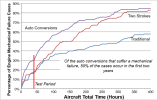midwestpa24
Final Approach
- Joined
- Mar 4, 2016
- Messages
- 5,006
- Display Name
Display name:
midwestpa24
In my lifetime, I have known 5 pilot/builders that had auto engine powered experimentals. All spent far more time and money engineering, tinkering, and repairing their one of a kind setup. All experienced multiple small, and sometimes large, failures. All of these aircraft have either been re-engined with Lycomings or have been scrapped out.
I'm not saying it can't be done, but I just can't figure out why it should. It just seems like a square peg, round hole type of solution.
I'm not saying it can't be done, but I just can't figure out why it should. It just seems like a square peg, round hole type of solution.

